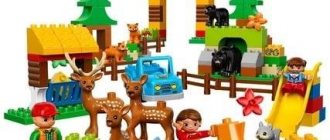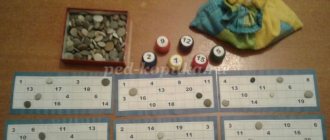Sand therapy for preschool children
For babies, this therapy is a fun way to touch soft-touch material. It helps children develop mentally and physically, giving them the opportunity to prepare for school.
For children, playing in the sand helps:
- learn numbers and letters;
- distinguish between left and right sides;
- correctly navigate the seasons;
- train memory, vision and hearing;
- develop imagination.
It is better to start such therapy at the age of 3, but it can be done earlier, when the child stops putting everything in his mouth.
Stages of sand therapy
There are three main stages of sand play:
- “Chaos” - there are no differences between the figures, that is, it is not clear who they are: animals, heroes, plants, fairy-tale characters. This means that the baby is anxious and restless.
- “Struggle” - the child clearly divides toys into good and bad, and there are many more evil ones. This period is called the child’s internal struggle; in this case, good characters should be added to his game’s plot.
- “Exodus” is the stage that means complete calm and harmony of the child.
Sand therapy fully develops the child and eliminates neurological problems. It is also just a pleasant and useful time spent with your own child.
How does sand therapy work?
The main effect of sand therapy is that it helps fight psychological trauma by transferring it to the sand. Feelings of control and interconnection over one’s internal sensations and desires begin to form. A child, playing in the sand, expresses all his experiences and fears, frees himself from traumas that do not develop into psychological trauma.
Interesting read:
“Call me kindly” – speech therapy game
Integrated speech development lesson for children 5-6 years old using eidetic elements
Sand therapy in child development
Thanks to sand therapy, you can develop the following skills in your child:
- Motor. The child learns to pour sand into a bucket, jar or bottle with a narrow neck.
- Descriptive. Preschoolers draw animals, plants, equipment, etc. in the sand.
- Develop speech functions and phonemic hearing. Children draw letters in the sand, which helps teach them how to pronounce and automate sounds.
- Development of mental abilities, memory and attention.
- Development of fine motor skills of the hands. Every finger is involved in the game, which will have a beneficial effect on the overall development of the child.
- To correct breathing. Sand acts as a means for breathing exercises.
Playing in the sandbox helps the child perform actions with sand: dry and wet. He learns its properties and learns to establish a cause-and-effect relationship. In the process, creative abilities also develop - the child comes up with new images and makes them out of sand.
Game techniques
What is needed for sand therapy at home
If parents want to organize sandplay at home, then for this they will need:
- pallet;
- sand;
- Miniature figures;
- Pebbles, plants, etc. to create a certain landscape.
Depending on the objectives, sand therapy can take place in the form of games aimed at:
- development of phonemics;
- correction of sound pronunciation;
- literacy training;
- educational games;
- family sand therapy;
- projection games.
The lesson includes the following plan:
- We introduce the child to the sandbox, explain that the blue side symbolizes the sky, that you can create any type of terrain: mountains, deserts, and by spreading the sand - the blue sea.
- We give you the opportunity to hold in your hands a collection of geometric shapes, animals, and household items.
- The figures that the baby chooses symbolize his condition today. The most important thing is to ask him to tell you what he thinks about the selected figures.
- We carefully observe the baby: how he enters the situation, with whom he identifies himself.
- We teach the child to be careful with materials.
- We formulate the topic at the beginning of sand therapy, conduct the classes according to the plan, and after its completion it is important to draw a conclusion about the work done, put all the used objects and toys in their places, and clean up after yourself.
Games to develop auditory attention and memory
- Games aimed at increasing vocabulary and constructing detailed phrases.
By the age of three, a person can pronounce basic words correctly. Some children speak unclearly, swap syllables and letters in words, and place stress incorrectly. If he does not pay attention to speech problems, by the age of 5 he realizes that he is speaking incorrectly and begins to feel embarrassed about it and withdraws into himself. You can arrange speech games in the sand. To do this, children draw letters, learn to form syllables and pronounce them loudly or quietly, in a chant, in a whisper.
Having placed different figures in a container, we teach the child to name the animals, write - what letter its name begins with, and what sounds these animals make. You can play tic-tac-toe.
- Educational geographical games on the sand.
After simple games with building houses, rivers, seas and boats, we begin to develop spatial thinking. For classes, a map of the world or continents made independently in the form of a puzzle is suitable. To do this, you need to purchase two identical geographical maps in the store and divide one into 4-6 fragments. We give the child a sample card and offer to put together a puzzle. Gradually we begin to fold continents and oceans. Then we complicate the game by making a “sea” at the bottom of the sandbox, spreading the sand. During the game, we pronounce the names of countries, their capitals, and find out who lives there. For example, in France the capital is Paris, and the French live there.
For each country we select characteristic vegetation and animals, placing palm trees, elephants, and crocodiles in the sandbox. We explain what a tropical climate is and why birches don’t grow there. You can travel to the North Pole by first making a supply of salt, polystyrene foam or cotton wool for snow.
- Fantastic games with transformers on the sand.
We imitate the life of other planets, the lunar landscape, Star Wars, which will be especially interesting to boys, will help them realize their desire to be a superhero, teach them how to fight and win.
Depending on the age of children, in addition to geographical and fantasy games, there are the following types of educational games:
- historical;
- find logical pairs;
- learn to eliminate unnecessary things;
- take a tour of the city;
- count objects, build logical series;
- learn to navigate: what is - above, below, right, left.
The role of sand therapy for children with disabilities
For healthy children, such games are simply useful and entertaining. The situation is different with children with developmental disabilities. Sand exercises are used to correct behavior, relieve tension and develop sensory skills.
Games in the sandbox are effective for kids with:
- ZPR;
- HIA;
- ONR.
Such children form their own character in the sandbox; the characters communicate with each other and carry on a conversation. This is how kids with developmental disabilities form their own character.
The sand literacy game is suitable for children with speech delays. It improves the correct perception of words, forms correct pronunciation, develops reading and writing.
Children with intellectual deficiencies should play with sand for about an hour.
This therapy treats neurological problems and is an active prevention of developmental disorders. Frequent play in the sandbox charges the child with positive emotions and frees him from negative manifestations of the outside world.
Actions of the teacher when organizing sand therapy
When organizing sand therapy, the teacher should:
- prepare a place for sand therapy. This should be a quiet corner where there is no noise and fuss;
- purchase a box that needs to be painted blue or light blue. This coloring has a beneficial effect and calms the psyche. Pure white sand is poured into it;
- A box of toys is placed near the box. They should be small in size so that the child can create a model of the game. The set must include figures of people and animals;
Note! During sand therapy, the child chooses exactly those figures that symbolize his internal state at the moment.
- create comfortable conditions for gaming activities;
- support children's play, help them experience various situations;
- evaluate children's behavior during play and draw conclusions.
To practice sand animation you need:
- Buy a table with a glass top and add lighting from below. Install low edges along the edge of the table.
- Pour clean river sand onto the surface in such quantity that you can draw pictures on it.
During therapy sessions there should be a calm environment conducive to therapy. You can turn on calm music. The teacher observes the progress of the game and, if necessary, prompts the child with a scenario.
Equipment for classes
The following devices are used for therapeutic play:
- a waterproof box, the walls of which are painted blue and the bottom is blue;
- special sandbox that changes color - tablet;
- clean sand, which must be moistened during certain games;
- a set of figures symbolizing buildings, people, animals, cars;
- symbolic objects that will represent wishes made, treasure chests, treasures;
- fairy-tale heroes - good and evil;
- religious items and souvenirs;
- natural objects - shells, twigs, cones;
- home stuff;
- bolts, screws;
- plastic letters and numbers, geometric shapes.
After testing, educational games for preschoolers begin according to their needs, age, identified disorders, and cognitive disorders.
In the future, you can include interactive, developmental activities and only then - projective games and exercises.
Features of sand therapy for children
Sand therapy is also suitable for adults, but the use of sand therapy has its own characteristics in games:
- Does the teacher understand the child’s psychological problem?
- It is important to set communication boundaries with children.
- A more natural game, which is unusual for adults.
- Children are engaged in more dynamic and active games.
- The main stages of the game: chaos, struggle, outcome.
- Complete absence of abstract paintings.
- The preferred predominance of fairy-tale characters, animals, and cartoon characters in the game.
The benefits of sand therapy for children
The advantages of working with sand are undeniable:
- Fine motor skills develop in preschool children.
- Extensive scope for imagination and mental activity.
- The thinking mechanism is regulated.
In speech therapy classes, doing exercises with sand helps:
- express your thoughts logically;
- formation of dialogical speech of preschoolers;
- bear responsibility for your actions in the game;
- rely only on your own strength;
- erase psychological traumas and problems from your head.
Sand therapy methods in speech development
Speech disorders often occur in preschool children. Sand therapy is an effective tool for children's speech development. This method is novel and increasingly gaining popularity.
A speech therapist uses sand games in classes with children:
- "Sounds on the Sand"
The teacher draws an animal or object in the sand and asks the child its name. Then he asks to draw other objects whose names begin with the first sound of the word. Thanks to this game, the speech therapist helps the child automate a specific sound.
- "Remove the unnecessary"
The teacher draws 3 objects, one of them does not fit the logical chain. For example, circle, square and apple. The child must erase the excess and add the necessary drawing. Sand play promotes speech development.
- "Turn the letter"
The teacher draws a letter, the child must turn it into another.
- “Draw a letter, a word”
The preschooler draws with his finger the letters or words that the teacher pronounces. In the game you can use sticks or string with knots to write.
Important! The speech therapist will select sand therapy individually for each child, which is necessary for him to produce sound and automate it.
Stages of organizing sand therapy in kindergarten
Sand therapy is organized by teachers in kindergartens, psychologists and speech therapists. They use sand games for activities with children. At home, parents can organize a place where the child can play in the sandbox for his own benefit.
The main stages of organizing therapy include:
- Preparing a child for sand therapy. He must have a desire to participate in the game.
- The teacher must be able to conduct sand therapy, have a creative approach and potential.
- Children must be healthy at the time of play. They should not have an allergic reaction to sand.
- Preparing the play area: a box of sand, an animation table and toys.
- Carrying out the game.
There are many options for sand games. A competent specialist will select the necessary methods that are necessary for the development of a particular child.
Sand can fascinate with its amazing possibilities. Notice how many different fantasies can be realized in a sand drawing. It’s safe to say that not only children, but also adults can enjoy spending time with sand.
Related posts:
- Art therapy as a method of psychological influence Information about what art therapy is, how it affects…
- What is folklore and how to use its forms? Small forms of folklore are successfully used in various types of activities for…
- Play in sensory education The role of play in sensory development - which didactic games are suitable...
- Experimental study of the development of coherent speech in preschool children with ODD. Diagnosis of coherent speech in children is carried out using accessible...







